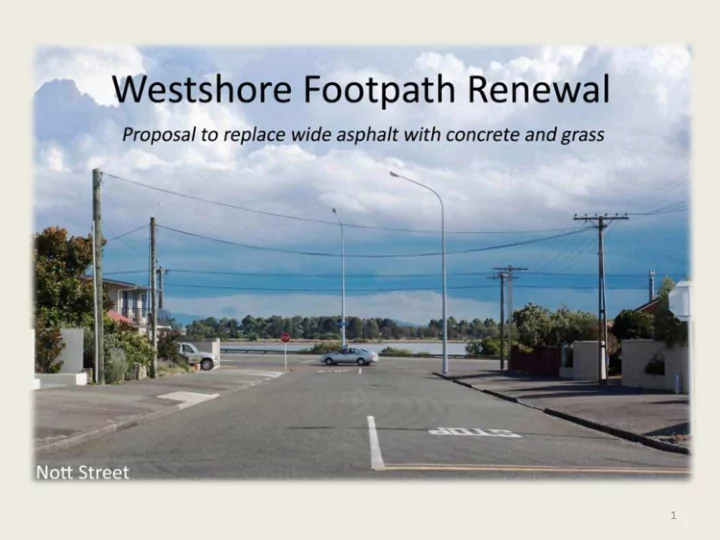

1
Introduction Westshore has an unusual legacy • of full-width asphalt footpaths Some of these are very wide and • would normally be grass berms with standard concrete paths between 1.2m and 1.5m wide These footpaths are due for • renewal so there is a window of opportunity to change to a more aesthetically pleasing streetscape Consultation with the residents is • required 2
Existing Westshore Footpaths Wide full-width asphalt paths Kerb to boundary widths vary • between 3.7m and 6m but most are around 5m The history of this unusual • residential layout is unknown These paths are mostly in Charles • Street and its side streets and the northern end of Ferguson Avenue 3
Existing Westshore Footpaths Narrow full-width asphalt paths Berms less than 3.5m wide are • considered narrow 3m berms could be replaced with • concrete and grass, but there would be no room for trees and it is quite likely there would be issues with existing utilities On berms less than three metres full • width asphalt remains the only practical option The Esplanade has the longest section • of this type of berm in Westshore. It is generally 2.5 metres wide 4
Existing Westshore Footpaths Narrow berms with concrete paths On narrow berms the concrete • path usually ends up adjacent to the kerb This layout generally results from • widening of arterial roads and comes at the expense of urban amenity Meeanee Quay has the longest • section of this type of berm in Westshore 5
Existing Westshore Footpaths Wide berms with concrete paths The only conventional grass berm • in Westshore is on the frontage of the Housing New Zealand units at the northern end of Charles Street The path could be closer to the • boundary to provide more space for street trees between the path and the kerb The picture shows that a healthy • grass berm is achievable in the coastal environment 6
The affected footpaths – asphalt wider than 3.5m Westshore Half of Ferguson Nearly all of Most side Avenue Charles Street streets 7
Proposed reconfiguration – Charles Street From this: 8
Proposed reconfiguration – Charles Street To this: 9
Proposed reconfiguration – Naomi Street From this: 10
Proposed reconfiguration – Naomi Street To this: 11
Environment and amenity Grassed berms are environmentally • preferable to impermeable surfaces. Turf absorbs and filters run-off water while paved areas concentrate it Dark asphalt with its low “albedo” • (reflectivity) contributes to the heat sink effect of urban areas Grass looks better, especially with • the addition of street trees More street trees are in keeping • with the greening of Napier 12
Cost comparison The initial cost of replacing full • width asphalt paths with concrete and grass is about 50% higher than retaining the existing layout Asphalt lasts longer on paths than • on roads as the lighter loads are Versus more tolerant of brittleness caused by aging. They may last between 30 and 40 years Well constructed concrete paths, • clear of tree roots, should last in excess of 80 years 13
Network Utilities Without a footpath to follow some • utilities may have developed rather randomly in Westshore Power remains largely overhead • The current ultra-fast broadband (UFB) • rollout is starting in the “wealthy” suburbs where Telecom expects the highest initial uptake for the service Chorus is interested in installing UFB ducts • in conjunction with the proposed footpath works Other utility constraints could affect the • proposed changes in some places 14
Westshore School The school has wide full-width • asphalt paths on its three road frontages These have not been included in • the “asphalt to concrete” list pending consultation with the school If the school wants to change, • and/or if the pedestrian impact outside the school fence is light, then all or some of the school frontages can be included 15
Public Consultation Maintaining the grass berm is a long- • established urban convention Some Westshore properties have been • developed with no lawns and the owners may not wish to mow “their” new berms Some beach-front residents may not want trees • intruding into their views Street by street consultation will be needed • To be fair to all existing and future residents the • existing layout should only be retained if more than half the frontage owning residents in a street, or part of a street, reject the proposed change 16
Timing and funding Asphalt paths in various parts of the • city are generally the among highest priority for renewal Westshore is unique among residential • areas in having very wide asphalt paths The concrete versus asphalt question • needs to be determined so that a well- prioritised footpath renewal programme can be commenced in the current financial year The renewal of the aged footpaths • should be completed in stages within five years 17
Summary • Westshore’s wide asphalt footpaths are due for renewal • The full width paths are undesirable on environmental, economic and amenity grounds • It makes no sense to lock in an undesirable configuration by renewing it “as is” unless a clear majority of frontage-owning residents reject the proposed change • Appropriate consultation with the residents is required 18
Recommend
More recommend